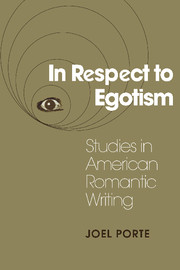Book contents
- Frontmatter
- Contents
- Preface
- Acknowledgments
- In Respect to Egotism
- Introduction: Writing, Reading, Romanticism
- 1 “Where … Is This Singular Career to Terminate?”: Bewildered Pilgrims in Early American Fiction
- 2 “Where There Is No Vision, the People Perish.…”: Prophets and Pariahs in the Forest of the New World
- 3 Poe: Romantic Center, Critical Margin
- 4 Emerson: Experiments in Self-Creation
- 5 Hawthorne: “The Obscurest Man of Letters in America”
- 6 Thoreau's Self-Perpetuating Artifacts
- 7 Melville: Romantic Cock-and-Bull; or, The Great Art of Telling the Truth
- 8 Douglass and Stowe: Scriptures of the Redeemed Self
- 9 Whitman: “Take Me as I Am or Not at All.…”
- Interchapter: Walt and Emily
- 10 Dickinson's “Celestial Vail”: Snowbound in Self-Consciousness
- Notes
- Index
- CAMBRIDGE STUDIES IN AMERICAN LITERATURE AND CULTURE
- Frontmatter
- Contents
- Preface
- Acknowledgments
- In Respect to Egotism
- Introduction: Writing, Reading, Romanticism
- 1 “Where … Is This Singular Career to Terminate?”: Bewildered Pilgrims in Early American Fiction
- 2 “Where There Is No Vision, the People Perish.…”: Prophets and Pariahs in the Forest of the New World
- 3 Poe: Romantic Center, Critical Margin
- 4 Emerson: Experiments in Self-Creation
- 5 Hawthorne: “The Obscurest Man of Letters in America”
- 6 Thoreau's Self-Perpetuating Artifacts
- 7 Melville: Romantic Cock-and-Bull; or, The Great Art of Telling the Truth
- 8 Douglass and Stowe: Scriptures of the Redeemed Self
- 9 Whitman: “Take Me as I Am or Not at All.…”
- Interchapter: Walt and Emily
- 10 Dickinson's “Celestial Vail”: Snowbound in Self-Consciousness
- Notes
- Index
- CAMBRIDGE STUDIES IN AMERICAN LITERATURE AND CULTURE
Summary
In 1982, when I produced the first draft of this book, I had in mind little more than a very loosely connected series of chapters on major American writers from Charles Brockden Brown to Emily Dickinson. Though I thought of them all as “Romantic” writers in some of the ways suggested in the Introduction, the book – perhaps with Matthiessen's American Renaissance as a model – was not intended to have a single overarching thesis. As I proceeded, however, I became aware of a persistent concern in the unfolding chapters, namely, an interest in modalities of selfdisplay or self-concealment – ways of figuring and disfiguring the selfdiscernible among American authors in this period. If that interest was continuous from writer to writer, it probably had less to do with there being something exceptional about American writing as such than with concerns and anxieties shared from one author to the next.
Simply put, American writing became a community project because the artists involved tended to think of themselves as pioneers engaged in clearing a common provincial imaginative space. As part of that project they individually and collectively kept one nervous eye on the culture and creations of England and western Europe, which provided both the impetus and the challenge for their own careers. In Harold Bloom's terms, they felt themselves to be both belated and empowered in respect to the antecedent culture. But, to repeat, those imperatives would be acted upon within a shared framework of new nationhood – implying new intellectual as well as new geographical territory.
- Type
- Chapter
- Information
- In Respect to EgotismStudies in American Romantic Writing, pp. xi - xiiPublisher: Cambridge University PressPrint publication year: 1991

